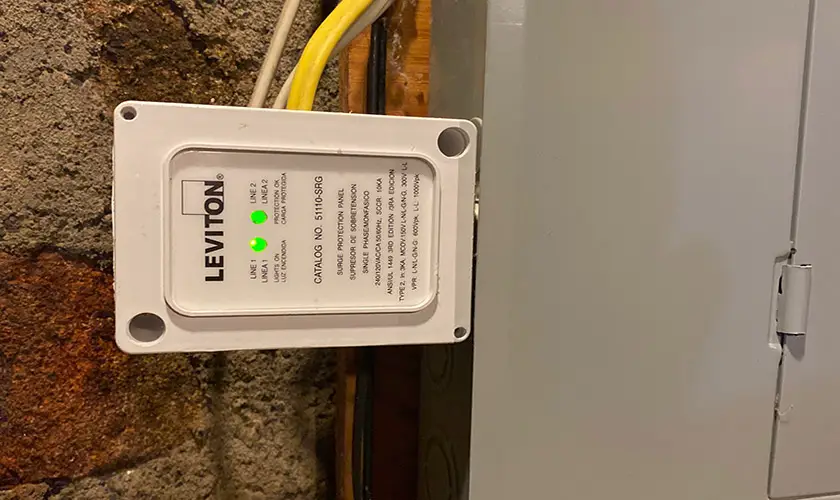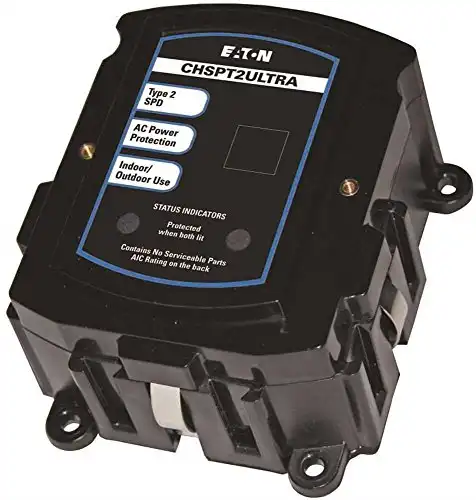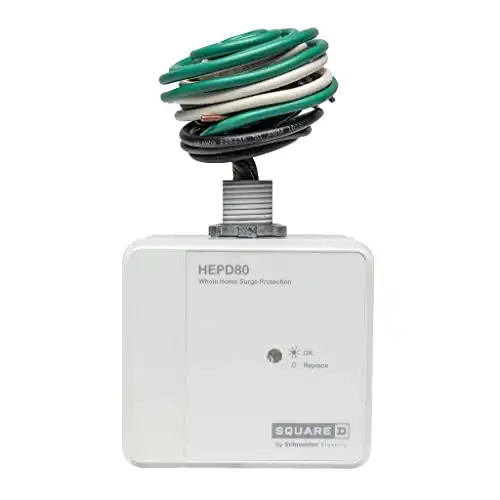
A whole house surge protector costs about $50 to $300, depending on the brand and quality. In addition, you’ll pay about $150 to $300, with an average cost of $175, for professional installation costs by a licensed electrician. You can expect a total cost of $200 to $600, with an average total whole house surge protector cost of $325.
A whole house surge protector device (SPD) prevents internal power surges and helps protect your home’s electrical system, large appliances, and electronics. A power surge can be caused by turning on a large appliance, a blackout, or a lightning storm.
According to the Insurance Information Institute, lightning strikes 20 million US homes annually, causing nearly $1 billion in property damage. The average claim was worth around $12,000. Major power surges occur without warning, so you have to be prepared. The whole house surge protector cost is minimal compared to the potential loss of expensive appliances or your home’s electrical system.
Here is a list of our picks for the best whole house surge protector.
| | | |
Is Whole House Surge Protector Cost Worth It?
Whole house surge protector cost is minimal compared to the protection it provides. We think every homeowner should have a whole house surge protection system. The National Fire Protection Association (NFPA) has even proposed that new homes have a Type 1 or Type 2 surge protector installed.
Insurance companies paid nearly a billion dollars in lightning claims to about 78,000 policyholders. At the very least, power surges damage home electronic devices, major appliances, and connected services such as security systems.
Not only can voltage spikes cause a fire, but they also present an electrocution hazard. By installing a whole-house surge protector, you can diminish this risk. Different devices are needed to protect communication lines from voltage surges, so it’s safest to hire a professional for installation.
Do Whole House Surge Protectors Work?
A whole-house surge protector (whole house suppressor) prevents circuits from being overloaded by a power surge. In contrast, individual plug-in power strip surge protectors can only protect plugged-in devices. Home appliances like stoves, HVAC units, dishwashers, and washing machines are hardwired into electrical circuits and would not be protected by a plug-in surge protector.
While whole-house surge protectors can help to mitigate some of the damage from sudden power spikes, they are not foolproof.
Whole-house surge protection protects devices from voltage surges. A whole-home surge protector comes with a VPR (voltage protection rating), the maximum voltage allowed into your house’s electrical system. The voltage rating can vary depending on the type of whole-house surge protector.
A whole-home protector with a high VPR might allow for smaller surges that could harm small appliances and sensitive electronics over time.
Many electricians suggest installing a high voltage whole house surge protector to protect large appliances and the home’s electrical system and use low voltage surge power strips for expensive electronics like computers, tablets, and smartphones.
Think of a whole house surge protector as a forcefield around your entire home and surge protecting power strips as sniper protection. It would be best if you had both for comprehensive coverage.
Types of Surge Protectors
Considering these, you’ll want to purchase the best surge protector for your home. There are three types of surge protectors available:
Type 1 – External Sources
Type 1 devices offer the best protection from external forces and surges. They can also defend against low-power surges, though these are rarely dangerous. Most people place their surge protectors at the electrical service meter base before the main breaker box.
Because you install this on the power line side, only safe amounts of electricity may enter your property. You must install Type 1 surge protection for structures while the home’s power is off. You need professional installation by a qualified electrician, which might raise the price considerably.
All surge protectors eventually wear out. To replace the Type 1 surge protection device, you’ll need to turn the power off again and have a qualified electrician do the professional installation.
Type 2 – Internal Surges
Type 2 whole house surge protectors are the most common type. They can be placed inside either the main panel or a subpanel. Generally, only those with some electrical knowledge and experience should attempt to install them.
A Type 2 surge device can guard a single circuit or the whole electrical panel. This is why having an expert electrician on board is advantageous.
Type 3 – Device Specific Surges
Type 3 point-of-use surge protectors are a type of wall outlet and power strip surge protector. They work by plugging into any household outlet and come with 4 to 6 additional electrical outlets, making them perfect for devices like TVs, computers, or gaming consoles.
Although surge protectors can stop most damage by absorbing excess power, they are not impenetrable.
How Long Does a Whole House Surge Protector Last?
Typically, you can expect a whole home surge protection device to last 5 to 10 years. However, our research found that an SPD can last for 2 to 3 years in areas with frequent power surges or outages.
The kA rating is a value that tells you how long the surge protector will last. Increasing the kA rating of the surge suppressor does not improve its protection performance. The higher the kA rating, the move voltage the surge protection device can absorb.
Think of this like the tread on a tire. As you drive on your tires, the tread wears off. This happens with surge devices too. The more times a surge protector absorbs a power surge, the more it wears down. Large surges can quickly deplete the SPD, while smaller surges take more time.
The frequency of the power surges also plays a role. Your SPD will wear out faster if you live in a house with old electrical equipment or in an area with frequent blackouts.
The kA rating is how much power the surge protector can take before it breaks. This kA number is determined by how many metal oxide varistors (MOVs) are in the surge protector.
The lifespan of a whole house surge protector varies and is determined by how frequently power surges occur in your area. Some top companies offer warranties for 5 years, but these devices often last much longer. However, they will wear out over time and need to be replaced eventually.
A surge protector is a device that guards your electronics against damage caused by strong electrical surges. Because of the long-term effects of surges, any home, business, or entertainment center should have one. These devices will not last forever, so you must keep an eye on them.
These protectors work by absorbing excess voltage into a metal oxide varistor (MOV). The more voltage that is absorbed, the faster the MOV degrades. Eventually, the surge protector will provide no protection. Fortunately, the best surge protectors have an indicator light to alert you to their status. Some also feature audible alarms.
Our favorite whole-house surge protector, Leviton Whole House Surge Protector, has a limited lifetime warranty.
Will Home Insurance Cover Power Surge Damage?
The Insurance Information Institute reports that some homeowner policies cover damage from power surges if lightning directly hits your home. Most home insurance policies also include protection against accidental or sudden destruction caused by artificial sources.
If a storm caused the power surge, your insurance policy would likely cover costly repairs or replacements. Depending on your insurance provider and plan, they may contribute a prorated amount to the repair or replacement costs. Still, you should double-check if this is included in your coverage by reading the fine print.
Power surges are just one of the many specialized coverages that homeowners may be asked to purchase. Your insurance broker will likely suggest power surge coverage if you live in a stormy region. Inquire with your insurance provider or agent about what exactly is covered by your policy.
Will a Whole House Surge Protector Trip?
Minor power surges happen frequently and often go unnoticed. It’s rare for a whole house surge protector to trip a breaker. Whole home surge protectors absorb excess voltage from the electrical current rather than trip breakers.
Whole house surge protectors allow up to 15% of excess voltage to pass through the electrical system. Breakers often sustain up to 20% overcurrent before the circuit breaker trips.
Breakers trip for a multitude of reasons, many of which are unrelated to power surges. If you have a tripping circuit breaker, it may be unrelated to a power surge and the surge protector, so you should consult a licensed electrician.
Can I Install a Whole House Surge Protector Myself?
It’s best if a licensed electrician installs a whole house surge protector to ensure a professional installation. If you have some basic knowledge of electrical work, installing an entire house surge protector can be done relatively quickly. For your safety, we recommend calling in a licensed electrician.
Do New Homes Need Whole House Surge Protectors?
In 2020, the National Electrical Code started requiring surge protection in residential dwellings. Adoption of NEC codes varies, so check with your municipality. In areas where adopted, new and replacement electrical equipment and systems must have Type 1 or Type 2 surge protection.
Type 1 is installed at the meter base and requires professional installation. Type 1 surge protection devices are becoming standard in newly constructed homes.
Type 2 is installed at the electrical panel but doesn’t necessarily require professional installation. Type 2 surge protection is found in existing home renovations because it doesn’t involve shutting off the power to the house for installation.
How Long Does it Take to Install a Whole House Surge Protector?
Professional installation of a whole house surge protector takes about 2 hours. Installation involves removing the electrical panel cover and doing electrical work inside the electrical breaker panel, which can be highly dangerous and should not be done by a novice homeowner. Unless you are a skilled electrician, we recommend you hire a licensed electrician.
Get FREE estimates from licensed electricians in your area today. Whether you need to replace an outlet, hang a ceiling fan, a new electrical panel, or repair wiring, We Can Help!











